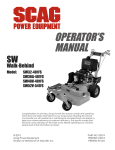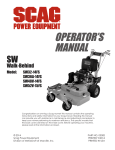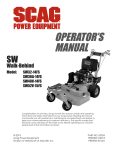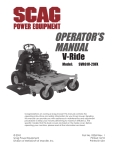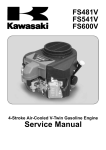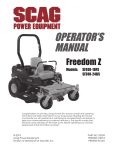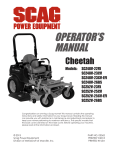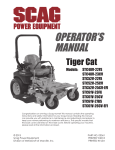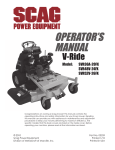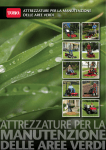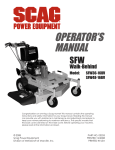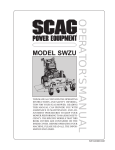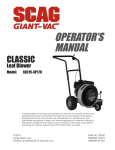Download Scag Power Equipment SWZT36-481FS Operator`s manual
Transcript
OPERATOR’S MANUAL SWZT Walk-Behind Model: SWZT36-481FS SWZT48-541FS Congratulations on owning a Scag mower! This manual contains the operating instructions and safety information for your Scag mower. Reading this manual can provide you with assistance in maintenance and adjustment procedures to keep your mower performing to maximum efficiency. The specific models that this book covers are listed on the inside cover. Before operating your machine, please read all the information enclosed. © 2013 Scag Power Equipment Division of Metalcraft of Mayville, Inc. PART NO. 03332 PRINTED 3/2013 PRINTED IN USA WARNING FAILURE TO FOLLOW SAFE OPERATING PRACTICES MAY RESULT IN SERIOUS INJURY OR DEATH. • Read this manual completely as well as other manuals that came with your mower. • ALWAYS FOLLOW OSHA APPROVED OPERATION. • DO NOT operate on steep slopes. • Always travel across slopes. • DO NOT mow on wet grass. Wet grass reduces traction and steering control. • Keep all shields in place, especially the grass discharge chute. • Before performing any maintenance or service, stop the machine and remove the spark plug wire and ignition key. • If a mechanism becomes clogged, stop the engine before cleaning. • Keep hands, feet and clothing away from power-driven parts. • Keep others off the mower (only one person at a time) REMEMBER - YOUR MOWER IS ONLY AS SAFE AS THE OPERATOR! Hazard control and accident prevention are dependent upon the awareness, concern, prudence, and proper training of the personnel involved in the operation, transport, maintenance, and storage of the equipment. This manual covers the operating instructions and illustrated parts list for: SWZT36-481FS with a serial number of J3400001 to J3499999 SWZT48-541FS with a serial number of J3500001 to J3599999 Always use the entire serial number listed on the serial number tag when referring to this product. Table of Contents R Table of Contents SECTION 1 - GENERAL INFORMATION. ..................................................................................1 1.1 Introduction............................................................................................................................................1 1.2 Direction Reference............................................................................................................................1 1.3 Servicing The Engine And Drive Train Components..................................................................1 1.4 Symbols.....................................................................................................................................................2 SECTION 2 - SAFETY INFORMATION.......................................................................................3 2.1 Introduction............................................................................................................................................3 2.2 Signal Words...........................................................................................................................................3 2.3 Before Operation considerations.................................................................................................3 2.4 Operation Considerations.................................................................................................................4 2.5 Maintenance Considerations & storage.....................................................................................6 2.6 Using a spark arrestor......................................................................................................................6 2.7 sPARK IGNITION SYSTEM..........................................................................................................................6 2.8 SAFETY AND INSTRUCTIONAL DECALS..................................................................................................7 SECTION 3 - SPECIFICATIONS.................................................................................................8 3.1 ENGINE.........................................................................................................................................................8 3.2 Electrical................................................................................................................................................8 3.3 ENGINE DECK..............................................................................................................................................8 3.4 Cutter Deck.............................................................................................................................................8 3.5 Weights and Dimensions......................................................................................................................9 3.6 PRODUCTIVITY............................................................................................................................................9 SECTION 4 - OPERATING INSTRUCTIONS............................................................................10 4.1 CONTROLS AND INSTRUMENT IDENTIFICATION .................................................................................10 4.2 SAFETY INTERLOCK SYSTEM.................................................................................................................11 4.3 INITIAL RUN-IN PROCEDURES.................................................................................................................11 4.4 STARTING THE ENGINE............................................................................................................................11 4.5 GROUND TRAVEL AND STEERING..........................................................................................................11 4.6 ENGAGING THE DECK DRIVE (CUTTER BLADES).................................................................................12 4.7 HILLSIDE OPERATION...............................................................................................................................13 4.8 PARKING THE MOWER..............................................................................................................................13 4.9 AFTER OPERATION...................................................................................................................................13 4.10 REMOVING CLOGGED MATERIAL.........................................................................................................13 4.11 MOVING MOWER WITH ENGINE STOPPED...........................................................................................14 4.12 RECOMMENDATIONS FOR MOWING.....................................................................................................14 SECTION 5 - TROUBLESHOOTING CUTTING CONDITIONS................................................15 I Table of Contents R SECTION 6 - ADJUSTMENTS..................................................................................................18 6.1 parking brake adjustment.............................................................................................................18 6.2 Neutral adjustment..........................................................................................................................18 6.3 NEUTRAL LATCH ADJUSTMENT.............................................................................................................19 6.4 Tracking adjustment.........................................................................................................................19 6.5 Throttle Control and Choke Adjustments.............................................................................20 6.6 BELT ADJUSTMENT..................................................................................................................................20 6.7 BELT ALIGNMENT......................................................................................................................................20 6.8 CUTTER DECK ADJUSTMENTS...............................................................................................................20 6.9 electric clutch adjustment..........................................................................................................22 SECTION 7 - MAINTENANCE. .................................................................................................24 7.1 MAINTENANCE CHART - RECOMMENDED SERVICE INTERVALS.......................................................24 7.2 Lubrication.............................................................................................................................................25 7.3 Hydraulic System................................................................................................................................26 7.4 Engine Oil................................................................................................................................................28 7.5 Engine Fuel System.............................................................................................................................28 7.6 Engine Air Cleaner..............................................................................................................................29 7.7 CUTTER BLADES.......................................................................................................................................29 7.8 TIRES...........................................................................................................................................................30 SECTION 8 - ILLUSTRATED PARTS LIST...............................................................................31 8.1 SCAG APPROVED ATTACHMENTS AND ACCESSORIES.......................................................................31 36" CUTTER DECK...........................................................................................................................................32 48" CUTTER DECK...........................................................................................................................................34 CUTTER DECK CONTROLS............................................................................................................................36 ENGINE DECK & HYDRAULIC SYSTEM.........................................................................................................38 STEERING CONTROLS....................................................................................................................................40 BRAKE COMPONENTS...................................................................................................................................42 ELECTRICAL SYSTEM AND THROTTLE CONTROL.....................................................................................44 SWZT FUEL SYSTEM.......................................................................................................................................46 ZT-2800 HYDRAULIC AXLE ASSEMBLY.........................................................................................................48 REPLACEMENT DECALS AND INFORMATION PLATES..............................................................................50 SWZT ELECTRICAL SCHEMATIC...................................................................................................................52 SECTION 9 - LIMITED WARRANTY - COMMERCIAL EQUIPMENT...............Following Section 8 II Section 1 R GENERAL INFORMATION 1.1 Introduction USE ONLY SCAG APPROVED ATTACHMENTS AND ACCESSORIES. Your mower was built to the highest standards in the industry. However, the prolonged life and maximum efficiency of your mower depends on you following the operating, maintenance and adjustment instructions in this manual. Attachments and accessories manufactured by companies other than Scag Power Equipment are not approved for use on this machine. See Section 8-1. WARNING If additional information or service is needed, contact your Scag Power Equipment Dealer. For pictorial clarity, some illustrations and figures in this manual may show shields, guards or plates open or removed. Under no circumstances should your mower be operated without these devices in place. We encourage you to contact your dealer for repairs. All Scag dealers are informed of the latest methods to service this equipment and provide prompt and efficient service in the field or at their service shop. They carry a full line of Scag service parts. All information is based upon product information available at the time of approval for printing. Scag Power Equipment reserves the right to make changes at any time without notice and without incurring any obligation. - IMPORTANT The replacement of any part on this product by other than the manufacturer's authorized replacement part may adversely affect the performance, durability or safety of this product. 1.2 Direction Reference Use of other than original Scag replacement parts will void the warranty. The “Right” and “Left”, “Front” and “Rear” of the machine are referenced from the operator’s right and left when in the normal operating position and facing the forward travel direction. When ordering parts, always give the model and serial number of your mower. The serial number plate is located on the frame of the machine near the engine and hydraulic pump as shown in Figure 1-1. 1.3 Servicing The Engine And Drive Train Components M S OD E E R L IA D iv L is io M n P a of ate yv M nts ille eta , Is W lcra su is ft ed co o n f an si M d n ayv P 53 ill en 0 e din 50 , In c. g R The detail servicing and repair of the engine and transmission are not covered in this manual; only routine maintenance and general service instructions are provided. For service of these components during the limited warranty period, it is important to contact your Scag dealer or find a local authorized servicing agent of the component manufacturer. Any unauthorized work done on these components during the warranty period may void your warranty. SERIAL NUMBER PLATE LOCATION Figure 1-1. Mower Serial Number Plate Location 1 Section 1 R 1.4 Symbols SYMBOL DESCRIPTION SYMBOL DESCRIPTION Choke Transmission Parking Brake Spinning Blade 48071S On/Start Spring Tension on Idler Off/Stop Oil Falling Hazard Thrown Object Hazard Fast Slow Continuously Variable - Linear Cutting Element - Basic Symbol Pinch Point Cutting Element - Engage Hour meter/Elapsed Operating Hours Cutting Element - Disengage Keep Bystanders Away Read Operator's Manual 481039S 2 Section 2 R SAFETY INFORMATION 2.1 Introduction Danger Your mower is only as safe as the operator. Carelessness or operator error may result in serious bodily injury or death. Hazard control and accident prevention are dependent upon the awareness, concern, prudence, and proper training of the personnel involved in the operation, transport, maintenance and storage of the equipment. Make sure every operator is properly trained and thoroughly familiar with all of the controls before operating the mower. The owner/user can prevent and is responsible for accidents or injuries occurring to themselves, other people or property. The signal word “DANGER” denotes that an extremely hazardous situation exists on or near the machine that could result in high probability of death or irreparable injury if proper precautions are not taken. Warning The signal word “WARNING” denotes that a hazard exists on or near the machine that can result in injury or death if proper precautions are not taken. R E A D T H I S O P E R ATO R ’ S M A N UA L B E F O R E ATTEMPTING TO START YOUR MOWER. A replacement manual is available from your authorized Scag Service Dealer or by contacting Scag Power Equipment, Service Department at P.O. Box 152, Mayville, WI 53050 or contact us via the Internet at www.scag.com. The manual for this machine can be downloaded by using the model and serial number or use the contact form to make your request. Please indicate the complete model and serial number of your Scag product when requesting replacement manuals. Caution The signal word “CAUTION” is a reminder of safety practices on or near the machine that could result in personal injury if proper precautions are not taken. Your safety and the safety of others depends significantly upon your knowledge and understanding of all correct operating practices and procedures of this machine. 2.2 Signal Words 2.3 Before Operation considerations WARNING This symbol means “Attention! Become Alert! Your Safety is Involved!" The symbol is used with the following signal words to attract your attention to safety messages found on the decals on the machine and throughout this manual. The message that follows the symbol contains important information about safety. To avoid injury and possible death, carefully read the message! Be sure to fully understand the causes of possible injury or death. Check all hydraulic connections for tightness. Inspect all hydraulic hoses and / or lines to insure they are in good condition before operating. 1. NEVER allow children to operate this mower. Do not allow adults to operate this machine without proper instructions. Signal Word: It is a distinctive word found on the safety decals on the machine and throughout this manual that alerts the viewer to the existence and relative degree of the hazard. 2. Do not mow when children and/or others are present. Keep children out of the mowing area and in the watchful care of a responsible adult other than the operator. Be alert and turn machine off if a child enters the area. 3 Section 2 R 3. DO NOT allow children to ride or play on the machine, it is not a toy. 11. Fuel is flammable; handle it with care. Fill the fuel tank outdoors. Never fill it indoors. Use a funnel or spout to prevent spillage. Clean up any spillage before starting the engine. 4. Clear the area to be mowed of objects that could be picked up and thrown by the cutter blades. 12. DO NOT add fuel to a running or hot engine. Allow the engine to cool for several minutes before adding fuel. Never fuel indoors or inside enclosed trailers. 5. DO NOT carry passengers. 6. DO NOT operate the machine under the influence of alcohol or drugs. 13. Keep flammable objects (cigarettes, matches, etc.), open flames and sparks away from the fuel tank and fuel container. Use only approved containers. 7. If the operator(s) or mechanic(s) cannot read English or Spanish, it is the owner's responsibility to explain this material to them. A Spanish decal kit is available for this model. See your local Scag Dealer. 14. See Section 7.4 ENGINE FUEL SYSTEM for fueling procedure. 8. DO NOT wear loose fitting clothing. Loose clothing, jewelry or long hair could get tangled in moving parts. Do not operate the machine wearing shorts; always wear adequate protective clothing including long pants. Wearing safety glasses, safety shoes and a helmet is advisable and is required by some local ordinances and insurance regulations. 15. Equipment must comply with the latest requirements per SAE J137 and/or ANSI/ASAE S279 when driven on public roads. 16. Do not operate without the side discharge chute installed and in the down position or with an optional grass catcher or mulch plate completely installed. 17. Check the blade mounting bolts at frequent intervals for proper tightness. WARNING 2.4 Operation Considerations Always wear hearing protection. Operating this machine over prolonged periods of time can cause loss of hearing. 1. Know the function of all controls and how to stop quickly. WARNING 9. Keep the machine and attachments in good operating condition. Keep all shields and safety devices in place. If a shield, safety device or decal is defective or damaged, repair or replace it before operating the machine. DO NOT operate on steep slopes. ALWAYS FOLLOW OSHA APPROVED OPERATION. WARNING 2. Reduce speed and exercise extreme caution on slopes and in sharp turns to prevent tipping or loss of control. Be especially cautious when changing directions on slopes. This machine is equipped with an interlock system intended to protect the operator and others from injury. This is accomplished by preventing the engine from starting unless the deck drive is disengaged and the transmission is in neutral. The system shuts off the engine if the operator releases the operator pressence levers with the deck drive engaged and/or the transmission is not in neutral. Never operate equipment with the interlock system disconnected or malfunctioning. 3. To prevent tipping or loss of control, start and stop smoothly, avoid unnecessary turns and travel at reduced speed. 4. Immediately apply the parking brake if you lose steering control while operating. Inspect the machine and correct the problem before continuing to operate. 5. When using any attachment, never direct the discharge of material toward bystanders or allow anyone near the machine while in operation. 10. Be sure the interlock switches are functioning correctly. 4 Section 2 R 6. Start the engine when the neutral latches are in the neutral lock position, the cutter blades are disengaged, parking brake is engaged and the speed control lever is in neutral. Caution Do not touch the engine or the muffler while the engine is running or immediately after stopping. These areas may be hot enough to cause a burn. 7. If the mower discharge ever plugs, shut off the engine, remove the ignition key, and wait for all movement to stop before removing the obstruction. WARNING DANGER DO NOT use your hand to dislodge the clogged discharge chute. Use a stick or other device to remove clogged material after the engine has stopped running and the blades have stopped turning. DO NOT run the engine inside a building or a confined area without proper ventilation. Exhaust fumes are hazardous and contain carbon monoxide which can cause brain injury and death. 8. Be alert for holes, rocks, roots and other hidden hazards in the terrain. Keep away from any dropoffs. Beware of overhead obstructions (low limbs, etc.), underground obstacles (sprinklers, pipes, tree roots, etc.). Cautiously enter a new area. Be alert for hidden hazards. 17. Keep hands and feet away from cutter blades and moving parts. Contact can injure. 18. Transport the mower using a heavy duty trailer or truck. Insure the trailer or truck has all of the necessary lighting and markings as required by laws, codes, and ordinances. Secure a trailer with a safety chain. 9. Disengage power to cutter deck before backing up. Do not mow in reverse unless absolutely necessary and then only after observation of the entire area behind the mower. If you must mow in reverse, maintain a constant lookout to the rear of the machine and mow slowly. 19. Be cautious when loading and unloading onto trailers or trucks. Use only a full width ramp. 20. When transporting the mower, make sure the speed control lever is in neutral, the neutral latches are in the neutral lock position, the engine is off with the key removed, the parking brake is engaged and the wheels have been blocked. 10. DO NOT turn sharply. Use care when backing up. 11. Disengage power to cutter deck before crossing roads, walks or gravel drives. 12. Mow only in daylight or good artificial light. 21. Tie the mower down securely using straps, chains, cable, or ropes. Both front and rear straps must be directed down and outward from machine. 13. NEVER raise the deck with the blades engaged. 14. Take all possible precautions when leaving the machine unattended, such as disengaging the mower, stopping the engine, and removing the key. 22. Use care when approaching blind corners, shrubs, trees, or other objects that may obscure vision. 15. Disengage power to the attachments when transporting or when not in use. 23. NEVER leave the machine running unattended. 16. The machine and attachments should be stopped and inspected for damage after striking a foreign object, and damage should be repaired before restarting and operating the machine. 5 Section 2 R 2.5 Maintenance Considerations & storage WARNING 1. Never make adjustments to the machine with the engine running unless specifically instructed to do so. If the engine is running, keep hands, feet, and clothing away from moving parts. Hydraulic fluid is under high pressure and can penetrate skin causing injury. If hydraulic fluid is injected into the skin, it must be surgically removed within a few hours by a doctor or gangrene may result. 2. Place the speed control lever in neutral, engage the parking brake, neutral latches in the neutral lock position, stop engine and remove key or disconnect spark plug wire to prevent accidental starting of the engine when servicing or adjusting the machine. Wait for all movement to stop before adjusting, cleaning or repairing. Keep body and hands away from pinholes or nozzles that eject hydraulic fluid under high pressure.Use paper or cardboard and not hands to search for leaks. Safely relieve all pressure from the hydraulic system by placing the control levers in the neutral lock position and shutting off the engine before performing any work on the hydraulic system. 3. Remove spark plug wire before making any repairs. 4. Keep all nuts, bolts and screws tight, to ensure the machine is in safe working condition. Check blade mounting bolts frequently to be sure they are tight. If you need service on your hydraulic system, please see your authorized Scag dealer. 5. Do not change the engine governor settings or overspeed the engine. See the engine operator's manual for information on engine settings. 13. Let the engine cool before storing. 6. To reduce fire hazard, keep the cutting units, drives, muffler and engine free of grass, leaves, excessive grease, oil and dirt. 14. DO NOT store the machine near an open flame. 15. Shut off fuel while storing or transporting. 7. Park the machine on level ground. 16. DO NOT store fuel near flames or drain indoors. 8. NEVER allow untrained personnel to service the machine. 2.6 Using a spark arrestor 9. Use care when checking blades. Use a Blade Buddy, wrap the blade(s) or wear gloves and USE CAUTION when servicing blades. Only replace blades. NEVER straighten or weld blades. The engine in this machine is not equipped with a spark arrestor muffler. It is in violation of California Public Resource Code Section 4442 to use or operate this engine on or near any forest covered, brush covered or grass covered land unless the exhaust system is equipped with a spark arrestor meeting any applicable local or state laws. Other states or federal areas may have similar laws. Check with your state or local authorities for regulations pertaining to these requirements. 10. Keep all parts in good working condition. Replace all worn or damaged decals. 11. Use jack stands to support components when required. 12. Carefully release pressure from components with stored energy. 2.7 sPARK IGNITION SYSTEM This spark ignition system complies with Canadian ICES-002. 6 Section 2 R 2.8 SAFETY AND INSTRUCTIONAL DECALS WARNING WARNING INSTALL BELT COvER BEFORE OPERATING MACHINE DO NOT OPERATE WITHOUT DISCHARGE CHUTE, MULCHING kIT, OR ENTIRE GRASS CATCHER INSTALLED READ OPERATOR'S MANUAL 483405 483402 483405 WARNING SPINNING BLADES ROTATING BLADES AND BELTS kEEP CLEAR * keep hands, feet & clothing clear * keep all guards in place * Shut off engine & disengage blade clutch before servicing * Use caution in directing discharge * Read instruction manual before operating BLADE CONTACT & THROWN OBJECTS CAN INJURE 483505 483505 DO NOT OPERATE UNLESS GRASS CATCHER, MULCHING kIT OR DISCHARGE CHUTE IS INSTALLED WARNING Operation of this equipment may create sparks that can start fires around dry vegetation. A spark arrestor may be required. The operator should contact local fire agencies for laws or regulations relating to fire prevention requirements. 483406 483406 483900 483900 (supplied with California models only) MOUNT RIDING ATTACHMENT HERE WARNING FALLING HAzARD USE ONLY SCAG APPROvED RIDING ATTACHMENTS SEE OPERATOR'S MANUAL 483404 483404 Avoid injury from burns - Shut off engine - Allow to cool several minutes - Remove cap slowly - Do not overfill EPACentroRLP / Q-08-027A 484377 Molded in Fuel Tank 484662 7 2013 SWZT Safety Decals Section 3 R SPECIFICATIONS 3.1 ENGINE General Type.................................................................................................Heavy Duty Industrial/Commercial Gasoline Brand...................................................................................................................................................................Kawasaki Engine Model: (Scag Model SWZT36-481FS)........................................................................................... Kawasaki Model # FS481V (Scag Model SWZT48-541FS)........................................................................................... Kawasaki Model # FS541V Displacement: Kawasaki FS481V............................................................................................................................................... 603cc Kawasaki FS541V............................................................................................................................................... 603cc Cylinders....................................................................................................................2 with Cast-Iron Sleeves - Kawasaki Governor.................................................Mechanical Type with Variable Speed Control Set At 3600 RPM (+/- 100 RPM) Idle Speed: Kawasaki.............................................................................................................................. 1550 RPM (+/- 150 RPM) Fuel....................................................................................... Non-Leaded Gasoline with a Minimum Octane Rating of 87 Oil Pump................................................................................................varies - see engine manufacturer's specifications Starter: Kawasaki.................................................................................................................................................... Recoil Start 3.2 Electrical Starter....................................................................................................................... Electrical Ignition with Recoil Starter Interlock Switches.................................................Operator Presence, Mower Engagement (BBC), Transmission Neutral Instrument Panel..................................................... Key Switch, Throttle Lever, Choke Control, PTO Switch, Hour Meter 3.3 ENGINE DECK Drive System.......................................................... Hydraulic Drive with Two Hydro-Gear™ Integraded Zero-Turn Axles Scag Model (SWZT36-481FS, SWZT48-541FS)......................................................................Hydro-Gear™ ZT-2800 Steering/Travel Control...........................................Independent Handle Controls for each wheel, squeeze to move from forward to neutral to reverse, neutral lock lever, speed range controlled with single lever (patented design) Parking Brake....................................................................Lever Actuated Linkage to Brakes on Both Drive Wheel Axles Wheels: (2) Front Caster.............................................................................. 9 X 3.5-4 Pneumatic Tubeless, w/Roller Bearings (2) Drive - .......................................... 18 x 6.5-8 (36) or 18 x 8.5-8 (48) Four-Ply Pneumatic Tubeless, Radius Edge Tire Pressure: Front Caster....................................................................................................................................................Flat Free Drive................................................................................................................................................................... 12 PSI Fuel Tank................................................... 5-1/2 Gallon Seamless Polyethylene Tank with Large Opening and Fuel Cap Travel Speed: Forward.................................................................................................................................................. 0 up to 7 MPH Reverse.................................................................................................................................................. 0 up to 3 MPH -NOTE- The machine will travel at 7 mph for transport purposes. For best cutting performance the forward travel speed should be adjusted depending upon the cutting conditions. 3.4 Cutter Deck Type......................................................................................................................................................... Out-Front design Construction................................................................................10-Gauge top with 11-Gauge reinforcement throughout the spindle area, 7-Gauge skirt for strength and longevity 8 Section 3 R True Cutting Width: 36..........................................................................................................................................................35.5" (90.2 cm) 48...........................................................................................................................................................48" (122.0 cm) Cutting Height Adjustment................................................................. Adjustment from, 1-1/2" to 4-1/2" in 1/4"increments Cutter Blades.............................................................................. 0.197 in. Thick, Milled Edge, Wear Resistant Marbain™ Blade Engagement.............................................................Electric Blade Engagement Clutch with Control Panel Switch Connected to the Cutter Deck through a Belt. Discharge Opening................................................ Extra Wide Discharge Opening with Spring-Loaded Discharge Chute Discharge Chute....................................................................................................Black, Polypropylene (Plastic), Flexible Spindles............................Heavy-Duty Spindle Shaft, Cast Aluminum Housing, Sealed Ball Bearing, Maintenance-Free Spindle Pulleys...................................................................................................................................................Split Steel Cutter Deck Belts....................................................................B-section with Kevlar Cord. Self-Adjusting, Self-Tightening Electric Clutch Type.................................................................................................Ogura Heavy Duty PTO Clutch Brake 3.5 Weights and Dimensions 36 48 Length............................................................................................................................. 75-1/2"............................75-1/2" Tracking Width................................................................................................................. 36-1/4"............................41-1/2" Overall Width w/chute down............................................................................................ 48-1/2"............................60-1/2" Overall Width w/chute up.................................................................................................... 37".....................................49" Overall Height..................................................................................................................... 44".....................................44" Operating Weight............................................................................................................... 550#................................. 585# 3.6 PRODUCTIVITY 36 48 Cutting Width...................................................................................................................... 36".....................................48" Acres Per Day..................................................................................................................... 9.3.................................... 12.4 The preceding chart will aid you in determining how many acres your Scag mower will cut per day. The chart is an estimate based on 8 hours per day cutting time at 4 MPH with a 20% allowance for overlap and turns. 9 Section 4 R OPERATING INSTRUCTIONS 2. Mower Deck Switch (Figure 4-1). Used to engage and disengage the mower drive system. Pulling up on the switch will engage the deck drive. Pushing down on the switch will disengage the deck drive. CAUTION Do not attempt to operate this mower unless you have read this manual. Learn the location and purpose of all controls and instruments before you operate this mower. 3. Engine Choke Control (Figure 4-1). Used to start a cold engine. 4. Engine Throttle Control (Figure 4-1). Used to control the engine speed. Pushing the lever forward increases engine speed. Pulling the lever back decreases engine speed. Full back position is the IDLE position. Full forward is the cutting position. 4.1 CONTROLS AND INSTRUMENT IDENTIFICATION 5. Left Steering Control (Figure 4-1). Used to control the mower's left wheel when traveling forward or reverse. Pull upward for neutral and reverse. Before operating the mower, familiarize yourself with all mower and engine controls. Knowing the location, function and operation of these controls is important for safe and efficient operation of the mower. 6. Right Steering Control (Figure 4-1). Used to control the mower's right wheel when traveling forward or reverse. Pull upward for neutral and reverse. 1. Ignition Switch (Figure 4-1). The ignition switch is used to start the engine. Turn the key to the on position before pulling the recoil starter. BRAKE LEVER ENGINE THROTTLE CONTROL ENGINE CHOKE CONTROL IGNITION SWITCH LEFT STEERING CONTROL RIGHT STEERING CONTROL OPERATOR PRESSENCE CONTROL OPERATOR PRESSENCE CONTROL NEUTRAL LATCH SPEED CONTROL LEVER MOWER DECK SWITCH NEUTRAL LATCH Figure 4-1. Controls and Instruments 10 Section 4 R 4.4 STARTING THE ENGINE 7. Speed Control Lever (Figure 4-1). Used to select the forward speed. 8. Neutral Latch (Figure 4-1). Used to secure the hydraulic drive system in neutral. Apply neutral latches when parking the machine. CAUTION 9. Operator Presence Control (Figure 4-1) The operator pressence control levers must be depressed before the speed control lever is shifted out of neutral or engaging the mower deck. DO NOT USE STARTING FLUIDS. Use of starting fluids in the air intake system may be potentially explosive or cause a “runaway” engine condition that could result in engine damage and/or personal injury. 10. Parking Brake Lever (Figure 4-1) Used to engage and disengage the parking brake. Pull the lever back to engage the parking brake. Push the lever forward to disengage the parking brake. 1. Be sure the fuel shutoff valve, located by the fuel tank, is completely open. (See Section 7.5.) 4.2 SAFETY INTERLOCK SYSTEM 2. Apply the neutral latch levers. 3. Shift the speed control lever into neutral. The mower is equipped with a safety interlock system that shuts off the engine if the operator releases the operator presence levers with the deck drive engaged and/or the speed control lever not in neutral or the parking brake disengaged. Never operate equipment with the interlock system disconnected or malfunctioning. 4. Place the PTO switch in the disengaged position. 5. Apply the parking brake. 6. If the engine is cold, choke the engine as needed. 7. Move the engine throttle control to about half engine speed. WARNING 8. Turn the ignition key to the ON position. 9. Pull the recoil starter on the engine. Never operate the mower with the interlock system disconnected or malfunctioning. Do not disengage or bypass any switch; injury to yourself and others or property damage could result. 10. Allow engine to warm before operating the mower. 4.5 GROUND TRAVEL AND STEERING - IMPORTANT If you are not familiar with the operation of a walk behind mower with a hydrostatic transmission, the steering and ground speed operations should be learned and practiced in an open area, away from buildings, fences, or obstructions. 4.3 INITIAL RUN-IN PROCEDURES First Day of Use or Approximately 20 Hours 1. Check all belts for proper alignment and wear at 2, 4 and 8 hours. Learn the operation on flat ground before operating on slopes. 2. Change the engine oil and oil filter after the first 20 hours of operation. (See Section 7.4.) Start practicing with a slow engine speed and slow forward travel. 3. Check for loose hardware. Tighten as needed. Learn to feather the steering controls to obtain a smooth operating action. 4. Check interlock system for proper operation. (See Section 4.2.) Practice operating the mower until you are comfortable with the controls before proceeding to mow. 5. Check tire pressure. Adjust pressure if necessary. (See Section 7.8.) 11 Section 4 R Forward Travel - NOTE The mower may not travel straight in reverse. To travel forward with the mower, depress the operator presence control, release the parking brake, select the desired speed using the speed control lever, pull steering control levers upward, release the neutral latch for both sides and slowly release both the left and right steering control levers. The higher the notch selected using the speed control lever, the faster the machine will travel. To steer left while traveling in reverse, pull upward on the right steering control lever. The further the lever is pulled upward, the quicker the mower will turn left. To steer right while traveling in reverse, pull upward on the left steering control lever. The further the lever is pulled upward, the quicker the mower will turn right. To stop the forward travel, pull upward on the steering control levers, lock the neutral latches, shift the speed control lever into neutral and apply the parking brake. 4.6 ENGAGING THE DECK DRIVE (CUTTER BLADES) To steer the mower left while traveling forward, pull upward on the left steering control lever. The further the lever is pulled upward, the quicker the mower will turn left. 1. Set the throttle at about 3/4 speed. Do not attempt to engage the deck drive at high speed as this shortens the electric clutch life — use only moderate engine speed when engaging the deck drive. To steer the mower right while traveling forward, pull upward on the right steering control lever. The further the lever is pulled upward, the quicker the mower will turn right. 2. Engage the deck drive by pulling out on the yellow switch, located on the instrument panel, to the engage position. See Figure 4-2. - NOTE Smooth operation of the steering control levers will produce smooth mower operation. While learning the operation of the steering controls, keep the travel speed low. Reverse Travel PULL UP TO ENGAGE Caution PUSH DOWN TO DISENGAGE 390S0138 Disengage power to the mower before backing up. Do not mow in reverse unless absolutely necessary and then only after observation of the entire area behind the mower. Figure 4-2. Cutter Engage Switch - NOTE A squealing noise may be heard when engaging or disengaging the deck drive. It is caused by the electric clutch plates meshing as the mower comes up to speed. This is normal. Caution 3. To disengage the deck drive, push the switch in to the disengage position. Before backing up, observe the rear for persons and obstructions. Clear the area before backing up. Possible injury or property damage could occur. 4. Always operate the engine at full throttle to properly maintain cutting speed. If the engine starts to lug down, reduce the forward speed and allow the engine to operate at maximum RPM. To travel in reverse, pull steering control levers upward. Keep the travel speed low while traveling in reverse. 12 Section 4 R 2. Keep the entire mower clean to inhibit serious heat damage to the engine or hydraulic oil circuit. 4.7 HILLSIDE OPERATION 3. Check the drive belts for proper alignment and any signs of wear. Correct and adjust if necessary. WARNING Danger DO NOT operate on steep slopes. ALWAYS FOLLOW OSHA APPROVED OPERATION. To avoid injury from burns, allow the mower to cool before removing the fuel tank cap and refueling. 1. This mower has been designed for good traction and stability under normal mowing conditions. However, caution must be used when traveling on slopes, especially when the grass is wet. Wet grass reduces traction and steering control. 4. After the mower has cooled down, fill the fuel tank with fresh, clean fuel at the end of every day of operation. See Engine Owner's Manual for proper octane requirements. 2. To prevent tipping or loss of control, do not start or stop suddenly, avoid unnecessary turns and travel at reduced speed. If tires lose traction, disengage blades and proceed slowly off the slope. 5. Check the tire pressure. Adjust pressure if necessary. 3. Avoid sudden starts when mowing on slopes. 4.10 REMOVING CLOGGED MATERIAL 4. Travel across the slope whenever possible. Never up and down the slope. 5. Keep tires properly inflated. Danger 4.8 PARKING THE MOWER ROTATING BLADES 1. Park the machine on a flat, level surface only. Do not park the machine on an incline. NEVER PUT YOUR HANDS INTO THE DISCHARGE CHUTE FOR ANY REASON! 2. Disengage the cutter blades. 3. Shift the speed control lever into the neutral position, lock the neutral latches and apply the parking brake. Shut off the engine and remove the key and only then use a stick or similar object to remove material if clogging has occurred. 4. Slow the engine to idle speed. 5. Turn the ignition key to the OFF position and remove the key. 1. If the discharge chute becomes clogged, shut off the engine and remove the ignition key. Using a stick or similar item, dislodge the clogged material. Then resume normal mowing. 4.9 AFTER OPERATION 1. Wash the entire mower after each use. Do not use high pressure spray or direct the spray onto electrical components. - IMPORTANT Do not wash a hot or running engine. Cold water will damage the engine. Use compressed air to clean the engine if it is hot. 13 Section 4 R 4.11 MOVING MOWER WITH ENGINE STOPPED 3. Cut grass when it is dry and not too tall. Do not cut grass too short (cut off 1/3 or less of existing grass for best appearance). Mow frequently. To “free-wheel” or move the mower around without the engine running, move the dump valve control lever forward and out towards the drive wheels. See Figure 4-3. Disengage the parking brake and move the mower by hand. When the machine is in the desired position, engage the parking brake. The dump valve levers must be returned to the DRIVE position to drive the mower. 4. Keep mower and discharge chute clean. 5. When mowing wet or tall grass, mow the grass twice. Raise the mower to the highest setting for the first pass and then make a second pass to the desired height. 6. Use a slow travel speed for trimming purposes. 7. Operate the engine at full throttle for best cutting. Mowing with a lower RPM causes the mower to tear the grass. The engine is designed to be operated at full speed. "FREEWHEEL" POSITION "FREEWHEEL" POSITION DUMP VALVE CONTROL LEVER 8. Use the alternate stripe pattern for best lawn appearance. Vary the direction of the stripe each time the grass is mowed to avoid wear patterns in the grass. DUMP VALVE CONTROL LEVER Figure 4-3. Dump Valves 4.12 RECOMMENDATIONS FOR MOWING 1. Do not mow with dull blades. A dull blade will tear grass, resulting in poor lawn appearance and reduced mowing power. WARNING DO NOT operate without Discharge Chute, Mulching Kit, or entire Grass Catcher properly installed. 2. The discharge chute must not be removed and must be kept in the lowest position to deflect grass clippings and thrown objects downward. Direct the side discharge away from sidewalks or streets to minimize cleanup of clippings. When mowing close to obstacles, direct the discharge away from the obstacles to reduce the chance of property damage by thrown objects. 14 Section 5 R TROUBLESHOOTING CUTTING CONDITIONS Condition Cause Stringers - Occasional Low engine RPM Blades of Uncut Grass Width of Deck SGB020 Cure Run engine at full RPM Ground speed too fast Slow speed to adjust for conditions Wet grass Cut grass after it has dried out Dull blades, incorrect sharpening Sharpen blades Deck plugged, grass accumulation Clean underside of deck Belts slipping Adjust belt tension Streaking - Strips of Dull, worn blades Uncut Grass in Cutting Path Incorrect blade sharpening Sharpen blades Sharpen blades Low engine RPM Run engine at full RPM Belt slipping Adjust belt tension Deck plugged, grass accumulation Clean underside of deck Ground speed too fast Slow speed to adjust for conditions Wet grass Cut grass after it has dried out Bent blades Replace blades Not enough overlapping between rows Increase the overlap of each pass Width of Deck SGB018 Streaking - Strips of Uncut Grass Between Cutting Paths Width of Deck SGB019 Width of Deck 15 Section 5 R TROUBLESHOOTING CUTTING CONDITIONS (CONT'D) Condition Cause U ne v en C ut on F lat Lift worn from blade Ground - Wavy High-Low Appearance, Scalloped Blade upside down Cut, or Rough Contour Cure Replace blade Mount with cutting edge toward ground Deck plugged, grass accumulation Clean underside of deck Too much blade angle (deck pitch) Adjust pitch and level Deck mounted improperly See your authorized SCAG dealer Bent spindle area See your authorized SCAG dealer Dull blade Sharpen blade Uneven ground May need to reduce ground speed, raise cutting height, and/or change direction of cut Width of Deck SGB020 Uneven Cut on Uneven Ground -Wavy Appearance, High-Low Scalloped Cut, or Rough Contour Width of Deck SGB021 Sloping Ridge Across Tire pressures not equal Width of Cutting Path Check and adjust tire pressure Wheels uneven Check and adjust tire pressure Deck mounted incorrectly See your authorized SCAG dealer Deck not level side-to side Check for level and correct Width of Deck SGB023 16 Section 5 R TROUBLESHOOTING CUTTING CONDITIONS (CONT'D) Condition Cause Scalping - Blades Hitting Low tire pressures Dirt or Cutting Very Close to the Ground Ground speed too fast Width of Deck Cure Check and adjust pressures Slow speed to adjust for conditions Cutting too low May need to reduce ground speed, raise cutting height, change direction of cut, and/or change pitch and level Rough terrain May need to reduce ground speed, raise cutting height, and/or change direction of cut Ground speed too fast Slow speed to adjust for conditions Wet grass Cut grass after it has dried out SGB022 Step Cut - Ridge in Center Blades not mounted evenly of Cutting path Adjust pitch and level Bent blade Replace blade Internal spindle failure See your authorized SCAG dealer Mounting of spindle incorrect See your authorized SCAG dealer Width of Deck SGB024 Slope Cut - Sloping Ridges Bent spindle mounting area Across Width of Cutting Path Internal spindle failure Bent deck housing See your authorized SCAG dealer See your authorized SCAG dealer See your authorized SCAG dealer Width of Deck SGB025 17 Section 6 R ADJUSTMENTS 6.1 parking brake adjustment - NOTE If this procedure does not achieve proper brake adjustment, please contact your authorized Scag dealer. WARNING 6.2 Neutral adjustment Do not operate the mower if the parking brake is not operable. Possible severe injury could result. -NOTENeutral has been set by your Scag dealer at the time of set up and normally does not need to be adjusted. If, however, you find that the neutral has come out of adjustment, follow the procedure below. The parking brake linkage should be adjusted whenever the parking brake lever is placed in the “ENGAGE” position and the parking brake will not prevent the mower from moving. If the following procedures do not allow you to engage the parking brake properly, contact your Scag dealer for further brake adjustments. 1. Raise the drive wheels off the ground and block the caster wheels to prevent the machine from moving. 2. Make sure the speed control lever is in neutral, the steering control levers are in the neutral latch position, and the parking brake is on. Start the engine. 1. Park the machine on a flat surface and block the caster wheels to prevent the machine from moving. Remove the ignition key. 2. Disengage the parking brake. See Figure 6-1. 3. Release the steering controls from the neutral latch, release the parking brake and note if the tires are rotating. 3. Remove the cotter pin securing the pivot to the brake control linkage. See Figure 6-1. 4. Push down on the brake control rod to disengage the parking brake and adjust the pivot until it meets the mounting hole. Insert the pivot into the brake control linkage and secure with the cotter pin. 4. Start on the left side of the machine. Using a wrench, rotate the tracking adjustment nut counter clockwise just until the LH wheel starts to creep forward. Make note of the position of the adjustment nut. See Figure 6-2. 5. Repeat steps 3 and 4 on the other side of the machine. 5. Turn the adjustment nut clockwise just until the wheel turns rearward. Make note of the position of the adjustment nut. To adjust neutral, split the difference between the two noted positions of the adjustment nut. 6. Test the parking brake. 6. Repeat steps 4 and 5 on the right side as needed. ADJUST HERE ADJUST HERE Figure 6-1. Neutral Adjustment Figure 6-2. Neutral Adjustment 18 Section 6 R 6.3 NEUTRAL LATCH ADJUSTMENT -NOTEThis adjustment is made to allow the steering control levers to be moved out of the neutral latch without engaging reverse. 1. Raise the drive wheels off the ground and block the caster wheels to prevent the machine from moving. CONTACT HERE 2. Make sure the speed control lever is in neutral, the steering control levers are in the neutral latch position, and the parking brake is on. 3. Loosen the control rod jam nuts. See Figure 6-3. Figure 6-4. Control Rod Adjustment 5. Repeat steps 3 and 4 on the right side as needed. 6.4 Tracking adjustment LOOSEN HERE -noteBefore proceeding with this adjustment, be sure that the tire pressures are correct and the neutral adjustment and the steering control rod adjustment have been completed. ADJUST HERE LOOSEN HERE 1. With the machine on a flat level surface, start the engine, release the parking brake and place the speed control lever into the speed that will most often be used. 2. Squeeze the steering control levers and release the neutral latch. Slowly release the steering control levers, allowing the machine to move forward. WARNING Before attempting to make any tracking adjustments, move the speed control lever to the neutral position, place the blade engagement switch in the off position, apply the parking brake, and move the steering control levers into the neutral position. Figure 6-3. Control Rod Adjustment 4. Turn the steering control rod until the steering control lever makes contact with the neutral latch. Hold the steering control rod and tighten the jam nuts. See Figure 6-4. 19 Section 6 R 3. If the machine pulls to one side, stop the mower by placing the steering control levers in the neutral position. Using a wrench, turn the tracking adjustment nut on the slower side counter clockwise until the machine tracks straight. WARNING If the pump drive belt fails, steering control will be lost which could result in serious injury or death. Replace the pump drive belt as needed or every 400 hours / 2 years, whichever occurs first. 4. Bring the steering control levers back to the neutral lock position and check to see that the machine does not creep forward on the adjusted wheel. 5. If the machine creeps in neutral, you have moved out of the neutral band and will have to turn the tracking adjustment nut clockwise until the machine does not creep. 6.7 BELT ALIGNMENT Belt alignment is important for proper performance of your Scag mower. If you experience frequent belt wear or breakage, see your authorized Scag service center for belt adjustment. 6. Repeat steps 1 and 2. If the machine continues to pull to one side, stop the mower by placing the steering control levers in the neutral position. Turn the tracking adjustment nut on the faster side clockwise until the machine tracks straight. 6.8 CUTTER DECK ADJUSTMENTS 7. If tracking cannot be acheived, contact your Scag servicing dealer. Cutter deck level, pitch and height are set at the factory. However, if these adjustments should ever need to be made, the following procedures will aid in obtaining the proper cutter deck adjustment. 6.5 Throttle Control and Choke Adjustments - NOTE These adjustments must be performed by your Scag dealer to ensure proper and efficient running of the engine. Should either need adjustment, contact your authorized Scag service center. Before proceeding with the cutter deck adjustments, be sure that all tires are properly inflated. Cutter Deck Level 6.6 BELT ADJUSTMENT The cutter deck should be level from side-to-side for proper cutting performance. To check for level, be sure that the mower is on a flat, level surface, the tires are properly inflated and the cutter deck is set at the most common cutting height that you will use. On the RH side of the machine, check the distance from the top of the cutter deck to the floor. Next check the distance from the top of the cutter deck to the floor on the LH side of the machine. Both measurements should be the same. If the two measurements are different, the cutter deck level must be adjusted as follows: WARNING Before removing any guards, shut the engine off and remove the ignition key. All drive belts are spring loaded and self-tensioning, however after the first 2, 4, 8 and 10 hours of operation, the belts should be checked for proper alignment and wear. Thereafter, check the belts after every 40 hours of operation or weekly, whichever occurs first. 1. If the cutter deck is lower on one side, loosen the elastic stop nuts securing the hanger chains to the cutter deck on the front and rear of the lower side. See Figure 6-5. 20 Section 6 R ADJUST HERE ADJUST HERE Figure 6-6. Cutter Deck Pitch Adjustment Figure 6-5. Cutter Deck Level Adjustment 2. Move bolts on the front and rear deck hanger chains up or down in the slots until the cutter deck is level between both sides. See Figure 6-5 3. Hold the cutter deck in position and tighten the two (2) elastic stop nuts to secure the cutter deck in the proper position. 2. Move bolts on the front hanger chains up or down in the slots until the cutter deck pitch is equal between both sides. Hold the cutter deck in position and tighten the elastic stop nuts. Cutter Deck Pitch The pitch of the cutter deck should be equal between the front and rear of the cutter deck for proper cutting performance. To check for proper deck pitch, be sure that the mower is on a flat, level surface and the tires are properly inflated. Check the distance from the top of the cutter deck to the floor at the rear RH side of the cutter deck directly behind the cutter deck hanging chains. Next check the distance from the top of the cutter deck to the floor at the front RH side of the cutter deck directly in front of the cutter deck hanging chains. The measurement at the front of the cutter deck should be the same as the rear of the deck. Make these measurements at the LH side of the cutter deck also. If the measurement at the front of the deck is not the same, the cutter deck pitch must be adjusted as follows: 1. Loosen the elastic stop nuts securing the hanger chains to the front of the cutter deck. See Figure 6-6 and 6-7. ADJUST HERE Figure 6-7. Cutter Deck Pitch Adjustment - NOTE To prevent the cutter deck from teetering, all four (4) cutter deck hanging chains must have tension on them. If all four chains do not have tension on them and the deck teeters, you must readjust the cutter deck as outlined in the procedures above. All measurements should be taken from the top edge of the deck as the deck has an uneven bottom edge. 21 Section 6 R Cutter Deck Height 6.9 electric clutch adjustment The cutter deck height adjustment is made to ensure that the cutter deck is cutting at the height indicated on the cutting height index gauge. To check for proper deck height, be sure that the mower is on a flat, level surface and the tires are properly inflated. The electric clutch serves two functions in the operation of the mower. In addition to starting and stopping the power flow to the cutter blades, the clutch also acts as a brake to assist in stopping blade rotation when the PTO is switched off or the operator presence circuit is interrupted. 1. Push the cutter deck lift lever forward, hold and place the cutter deck in the 3" cutting position. When the clutch is disengaged, the air gap between the armature and rotor must be adjusted to fifteen thousandths of an inch, 0.015, for proper operation. The airgap adjustment is made at three bolts on the clutch. There are three inspection windows, one next to each adjusting bolt. See Figure 6-11. 2. Check the measurement from the floor to the cutter blade tip. If the measurement is not 3", an adjustment can be made using the slots in the cutter deck. 3. Loosen the elastic stop nuts securing the hanger chains to the front and rear of the cutter deck on both sides. See Figure 6-8. INSPECTION WINDOW (x3) - NOTE Only the right hand side of the cutter deck is shown below. Figure 6-9. Clutch Air Gap Adjustment 1. Locate the inspection windows on the clutch. 2. Place a 0.015 feeler gauge in the slot between the rotor and the armature. See Figure 6-10. INSERT 0.015 FEELER GAUGE HERE ADJUST HERE Figure 6-8. Cutter Deck Height Adjustment 4. Move bolts on the front and rear deck hanger chains up or down in the slots until the measurement at the cutter blade is 3" on both sides of the cutter deck. Figure 6-10. Clutch Air Gap Adjustment 3. Tighten or loosen the adjusting bolt as needed to acheive the 0.015 inch airgap. See Figure 6-11. Perform this operation at all three inspection windows. 5. Hold the cutter deck in position and tighten the elastic stop nuts to secure the cutter deck in the proper position 22 Section 6 R ADJUSTMENT NUTS ADJUSTMENT NUTS Figure 6-11. Clutch Air Gap Adjustment This adjustment should be done every 500 hours of operation or annually, whichever comes first. In cases where the machine is heavily used, airgap settings should be checked more often. If the air gap is too narrow, the clutch armature may drag when disengaged, resulting in premature failure. If the air gap is too wide, the clutch may be slow to engage as the magnet must pull the armature in from a greater distance. 23 Section 7 R MAINTENANCE 7.1 MAINTENANCE CHART - RECOMMENDED SERVICE INTERVALS HOURS Break-In (First 10) 8 20 40 100 200 Procedure 400 Comments X Check all hardware for tightness X C h e c k a l l b e l t s f o r p r o p e r See paragraph 7.6 alignment X Check all hydraulic fittings and See paragraph 2.5 hoses for leaks X Check engine oil level X *Clean mower X Check tire pressure See paragraph 7.8 X *Clean air filter element See paragraph 7.5 X Check condition of blades See paragraph 7.7 X Sharpen cutter blades See paragraph 7.7 X Check tire pressure See paragraph 7.10 X Check the operator inter lock See paragraph 4.2 system X X See paragraph 7.3 Change engine oil and filter See paragraph 7.3 Check belts for proper alignment See paragraph 7.6 X Check condition of fuel lines X Check all belts for proper alignment *Replace engine air filter See engine operator's manual X Grease caster wheel bearings See paragraph 7.2 X Drain hydraulic system, replace Use SAE 20W50 Motor Oil. hydraulic oil and filters See paragraph 7.2 X Check all hardware for tightness X Change engine oil See paragraph 7.4 X *Clean air cleaner element See paragraph 7.5 X 24 Section 7 R MAINTENANCE CHART - RECOMMENDED SERVICE INTERVALS (CONT'D) HOURS Break-In (First 10) 8 40 100 200 Procedure 400 Comments X Check hardware for tightness X Change engine oil filter See paragraph 7.4 X Replace engine fuel filter See paragraph 7.5 X Grease caster wheel pivot See paragraph 7.2 shafts X Drain hydraulic system, replace Use SAE 20W50 Motor Oil. hydraulic oil and filters See paragraph 7.2 X Adjust electric PTO clutch See paragraph 6.6 * Perform these maintenance procedures more frequently under extreme dusty or dirty conditions 7.2 Lubrication GREASE FITTING LUBRICATION CHART LOCATION LUBRICATION INTERVAL LU


























































